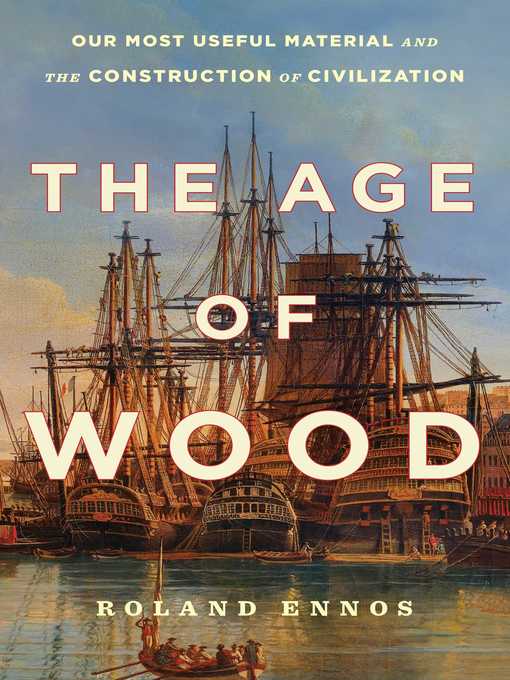
The Age of Wood
Our Most Useful Material and the Construction of Civilization
کتاب های مرتبط
- اطلاعات
- نقد و بررسی
- دیدگاه کاربران
نقد و بررسی

October 5, 2020
Ennos (Trees), a professor of biological sciences at the University of Hull, delivers an illuminating and fluidly written study of “the central role of wood in the human story.” Drawing from archaeology, anthropology, biomechanics, and architecture, among other academic fields, Ennos documents the links between trees and timber and a wide range of historical milestones, from the evolution of the human hand (primates developed soft pads on their fingertips and nails instead of claws in order to better grip tree branches) to the Boston Tea Party (inspired by an earlier riot in New Hampshire against British laws prohibiting the harvesting of large white pine trees). Ennos also examines the complexity of everyday wooden items; notes that the cellular structure of wood inspired the structure of plastics; and details the use of laminated wood in recent construction projects, including the Forte tower in Australia and the Richmond Olympic Oval in Canada. Extended discussions of bronze, wrought iron, steel, concrete, and plastics somewhat undermine the central argument that mankind has never fully left “the age of wood.” Still, this expansive history will give readers a newfound appreciation for one of the world’s most ubiquitous yet overlooked materials. Agent: Peter Tallack, the Science Factory.

October 15, 2020
Informative study of the crucial role of wood in the development of humans over centuries. "I hope [this book] will show that for the vast majority of our time on this planet we have lived in an age dominated by this most versatile material, and that in many ways we still do," writes Ennos, a professor of biological sciences who has authored textbooks on trees, statistics, and biomechanics. In this enthusiastic exploration, which begins in prehistory and moves to the present, the author digs deeply into paleoanthropology, tracking the earliest technological developments of man and what essentially brought them out of the forest--namely, climate change and the necessity of making fire. Ennos delves into a wide variety of disciplines, including social history, carpentry, geography, geology (specifically, how new energy sources such as peat and coal surpassed wood during the Industrial Revolution), and mechanical engineering. Even when iron and other materials replaced wood in some forms of construction, it still took wood (in the form of charcoal) to smelt the metals. "In the Middle Ages," writes the author, "around thirty pounds of wood was needed to smelt one pound of iron." Ennos also examines the supply of wood throughout history (into the 20th century, the New World's vast forests seemed inexhaustible), the intense labor required to move timber to manufacturing sites, and the high level of skill and focus involved in carpentry. The innovation of pig iron, cast iron, and wrought iron--all of which Ennos describes knowledgeably--transformed building into the 19th century and beyond. Yet even despite the widespread acceptance of such modern materials as steel, concrete, and plastic, as well as energy (oil), wood has continued relevance today--plywood, laminated wood, and wood pulp, among other applications. The author corrects some deforestation myths, discusses ecological disaster, and concludes with ways of "mending our strained relationship" with wood. An excellent, thorough history in an age of our increasingly fraught relationships with natural resources.
COPYRIGHT(2020) Kirkus Reviews, ALL RIGHTS RESERVED.

December 1, 2020
Beginning with a lively prologue about the 1772 New Hampshire Pine Tree Riot, which few Americans are likely aware of, Ennos (Trees, 2016) delivers an often surprising general history of humanity's long reliance on wood. Following a a look into primate biology to explore the evolutionary appeal of trees, the author discusses how wood was used for building fires, developing tools, hunting, and designing everything from ships to shelter. While the topic may be familiar, and Ennos' perspective is often focused on the West, there are plenty of intriguing histories to enjoy here and his amiable writing style is quite appealing. The opening revolutionary focus sets the stage for other gems from the past, and while the author has done a copious amount of research (documented via end notes), he imparts the facts he's gathered with wit and charm, such as when he notes the remarkable number of steps (102) to craft a bow and arrows. Smart and surprising, Ennos' inquiry proves that there is much we still need to learn about wood and how it has shaped our past and present.
COPYRIGHT(2020) Booklist, ALL RIGHTS RESERVED.

February 5, 2021
Biologist Ennos (Trees) examines how tree products have served us since our arboreal origins. Archaeologists have long organized human history into the stone, bronze, and iron ages while pointedly ignoring the importance of wood to human progress. Wood has long served us in the forms of tools, shelters, fuel, communication, and transportation. Of course, we cannot know the complete history of this close relationship, as, due to its organic structure, it is not often found in the oldest archaeological sites. However, we can hypothesize how our ancestors relied on wood throughout the centuries, especially as hunter-gatherer societies. As the author points out, every explorer from Leif Erikson to Sir John Franklin sailed in wooden vessels, and the Wright brothers first achieved flight with a wooden plane--it is difficult to imagine how our species would have interacted in the world without it. VERDICT This engaging natural history will draw in fans of Mark Kurlansky's Cod and Vince Beiser's The World in a Grain. It does a fantastic job of elevating humble wood to its rightful place alongside stone, bronze, and iron as a key resource in leading humanity to its dazzling achievements.--Brian Renvall, New Mexico State Univ., Carlsbad
Copyright 2021 Library Journal, LLC Used with permission.

























دیدگاه کاربران